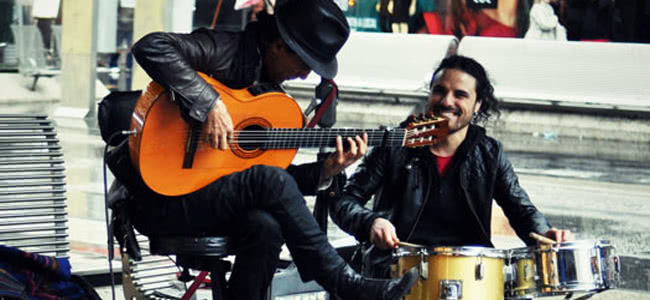Bringing music to the streets of Sydney is becoming increasingly difficult, at least that’s according to avant-garde violinist Jon Rose, who says that the age-old custom of busking has been “legislated to the point of non-existence,” in Sydney, as a report from The Age details.
The 2012 recipient of The Australia Council Don Banks Music Award for his outstanding and continued contribution to Australian music, Rose sees the Harbour city’s public liability policy and increasingly strict OH&S guidelines for buskers as stifling.
As he points out, for those wanting to take their music to the streets of Sydney, be prepared to study a nine page busking policy, 14 pages of allowed public performance spaces, fill out the four-page permit application, and then pay $45 for a permit. All of this on top of purchasing $2,000 in required public liability insurance, as outlined on the City of Sydney council’s website.
The rooftop of an Oxford St bookstore was the site of Rose’s one-hour amplified violin concert in 1983, but he says that scenario couldn’t happen today “without being arrested.”
Something that nearly happened in 2008, when Rose was busking outside the Sydney Opera House. Aiming to perform a 20-minute improvisation, he got halfway through before being stopped by a hyper vigilant security guard for “breaking bi-laws”. The incident was also captured on camera and put on YouTube. Rose sees the Harbour city’s public liability policy and increasingly strict OH&S guidelines for buskers as stifling.
Buskers must “be vetted, photographed … display their accreditation card, not sell other people’s CDs,” adds Rose, all before a musician is allowed to even play a note, he says.
Finding good public performance in Sydney takes “extreme diligence,” says the violinist, but says this shouldn’t be the case, particularly when great European cities like Paris, Moscow, and Berlin – he lists – have a thriving scene. His proposed initiatives include live music on trains, and making six hours of street performance part of music students’ accreditation.
The controversial artists is also a composer, software developer and instrument maker, who has a made a name for himself for his innovative performances and take on what is usually seen as a classical instrument.
Rose’s Relative Violin Project has seen him design over 20 deconstructed violin instruments, including a 19-string violin and the “Madonna and Child Violin”, which was essentially a violin bolted to a cello that allowed them both to be played at the same time.
One of his most celebrated works is his worldwide fence project, which saw Rose playing specially constructed fences like a violin, from Australia’s Rabbit-Proof fence to installations at arts festivals across Europe.
The 62-year old improvisational musician is so fed up with the current state of affairs for buskers that he has published an essay for Platform Papers entitled ‘The Music of Place: Reclaiming a Practice’ that explores the need for a city to allow musicians to grace their streets and public places.
It seems that it’s not just musicians who want to cut all the bureaucratic red tape around live music in Sydney. Following the closure of several of its iconic live music venues, the Sydney City Council launched the Live Music and Live Performance Taskforce, set to explore the issues of regulatory changes, bullying councils, and complaining residents that are hurting Sydney’s live music scene.
The Taskforce will look at “how to help venue operators negotiate the approvals process and manage noise, ways to open up new and unconventional spaces to performance, and how to support entrepreneurs and performers with staging events,” Lord Mayor Clover Moore has stated previously.
Perhaps opening up these “unconventional spaces” would help the issues that buskers encounter, appeasing street artists like Rose.

































